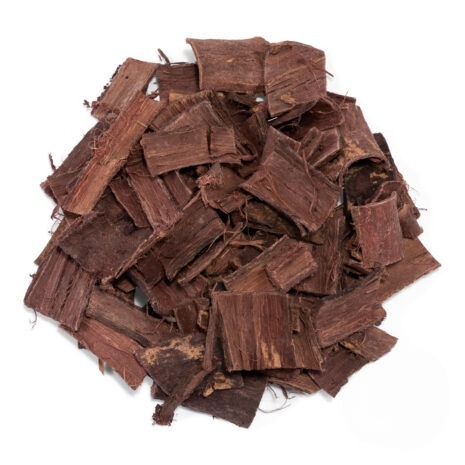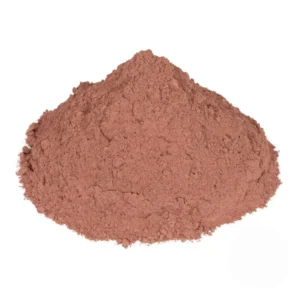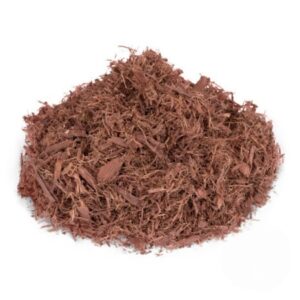Mimosa Hostilis Root Bark (Whole)
We sell Mimosa Hostilis Root Bark whole and in chunks in the US. These pieces come in different sizes because we strip them from the root in longer pieces, then dry them, and cut them into smaller chunks to make packaging and transport easier.
The shape and size of the root bark pieces help determine that they come from the roots, not the trunk. This matters because many vendors (mostly outside of Brazil) harvest the trunk bark, which offers lower quality and is much easier to collect.
Root bark pieces should:
- Display a natural curvature, since the root’s diameter is smaller than that of the trunk
- Have a rough outer texture, as trunk bark isn’t as rough
- Show a darker color on the outside
- Reveal a purple/pink color on the inside
We partner with farmers in the state of Bahia, Brazil, and this partnership gives us a consistent source of the highest quality Mimosa Hostilis root bark in the world. We take pride in following fair practices so everyone involved in harvesting this magnificent product receives a living wage.
We take whole bark strips as long as 2 or 3 feet from the root, then place them in large bags and transport them to a drying area to first remove all the dirt. After that, we cut them into smaller pieces and place them in drying rooms to dehydrate.
This natural drying process takes 2 to 3 weeks, depending on the humidity. We aim to produce a 100% dried product that results in purer inner root bark.
We don’t shred or powder these whole bark pieces until days before you place your order, ensuring you receive a fresh product.
Many of our customers prefer to buy the whole pieces and make the powder themselves, but they need to understand how difficult it is to shred or powder this bark. Customers can powder a small amount using a regular coffee grinder, but they will still struggle. For larger quantities, a professional or industrial mill is required.
Here is your content rewritten in active voice, with no information changed, and enhanced for clarity and flow while preserving your original structure and message:
What is Mimosa Hostilis Root Bark?
Mimosa Hostilis, also known as Mimosa Tenuiflora, grows natively in Brazil and Mexico. Its inner root bark provides powerful natural colorants, producing deep purples, reds, and browns. Indigenous peoples have used it for centuries, and today’s natural dyers value it for its environmental safety and strong performance as a sustainable dye.
Why Choose Mimosa Hostilis as a Natural Dye?
- Rich Color Output: It produces vibrant, long-lasting hues, from light lavender to deep burgundy, depending on the mordant and fabric.
- Natural Tannins: It acts as a built-in mordant, which makes it ideal for beginners.
- Eco-Friendly: It breaks down naturally, remains non-toxic, and poses no harm to water systems or skin.
- Cultural Heritage: By using Mimosa Hostilis, you support traditional knowledge and sustainable artistry.
How to Dye with Mimosa Hostilis Root Bark
What You’ll Need:
- Mimosa Hostilis root bark (powder or chips)
- Natural fiber fabric (cotton, wool, silk, etc.)
- A non-reactive dye pot (stainless steel or enamel)
- Water
- Mordants (optional: alum, iron, copper)
Steps:
- Simmer the bark in water for 1–2 hours to extract the dye.
- Strain out the solids.
- Soak pre-wetted, pre-mordanted fabric in the dye bath.
- Simmer gently for 45–60 minutes.
- Let the fabric cool, then rinse thoroughly and dry it in the shade.
Color Variations with Mordants
- Alum: Brings out reddish-purple tones
- Iron: Deepens the color to gray-purple
- Copper: Enhances warm, brownish shades
Great for Creative Projects
- Eco-Fashion: Dye natural fiber clothing and accessories
- Crafts: Add color to yarns, threads, and handmade paper
- Art: Use dye extracts in watercolor-style paints or eco-printing
Ethical Sourcing Tips
When buying Mimosa Hostilis root bark, always verify that the product comes from:
- Sustainably managed wild harvests
- Vendors who support indigenous communities
- Transparent, ethical supply chains
Final Thoughts
Mimosa Hostilis root bark offers more than just beautiful color—it creates a link to nature, heritage, and sustainability. Whether you’re a professional textile artist or a curious DIYer, this dye opens endless possibilities for eco-friendly creativity and supports a greener planet.
Disclaimer: Not for Human Consumption
This product is intended only for research, botanical, or external use. Do not consume. By purchasing this product, you agree to follow all applicable laws and regulations. The seller assumes no responsibility for misuse of this product.




Reviews
There are no reviews yet.